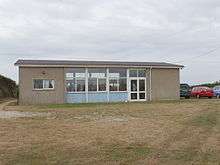St Eval
St Eval (Cornish: S. Uvel)[2] is a civil parish and hamlet in north Cornwall, England, United Kingdom. The hamlet is about four miles (6.5 km) southwest of Padstow.[3] The parish population at the 2011 census was 960.[4]
St Eval
| |
|---|---|
 St Eval church | |
 St Eval Location within Cornwall | |
| Population | 732 (civil parish 2011)[1] |
| OS grid reference | SW883685 |
| Civil parish |
|
| Unitary authority | |
| Ceremonial county | |
| Region | |
| Country | England |
| Sovereign state | United Kingdom |
| Post town | WADEBRIDGE |
| Postcode district | PL27 |
| Dialling code | 01841 |
| Police | Devon and Cornwall |
| Fire | Cornwall |
| Ambulance | South Western |
| UK Parliament | |
Much of the village land was acquired by compulsory purchase in 1938 to build an RAF Coastal Command Station, RAF St Eval. Many buildings were demolished leaving only the Norman church, the Vicarage, and Trevisker Farm. These buildings were effectively surrounded by RAF activity, and during World War II were taken over for RAF use, with the church tower used as an observation post and navigation mark.
The parish incorporates the southern part of Porthcothan and the hamlets of Engollan and Treburrick.
Parish church
In early times St Eval lay within the episcopal fief and peculiar deanery of Pawton. In 1297 the benefice was appropriated to the Dean and Chapter of Exeter; in 1312 the Dean and Chapter were in dispute with the vicar about the repair of the chancel. This was settled in 1322 by the vicar lengthening the chancel by six feet and rebuilding its walls. The aisle and tower were added before 1662 and in 1725 collections were made throughout the diocese for funds to rebuild the tower. The merchants of Bristol acknowledged the usefulness of the church tower as a sea mark and provided the funds for this in 1727.[5] The oldest part of the church is Norman but the north transept has been rebuilt. The south aisle is Perpendicular; the arcade has six arches but only four belong to the nave and the fifth arch is low but the sixth high again. Features of interest are the plain Norman font, the base of the rood screen, the octagonal pulpit dated 1688, and a good set of bench ends, reused in the restoration of 1889. The restoration was the work of J. D. Sedding. The stained glass (1989) commemorates the RAF station.[6] The churchyard contains the war graves of 23 Commonwealth air force personnel of World War II.[7]
St Eval church (dedicated to St Uvelus or Eval) was incorporated into the combined benefice of St Mawgan, St Ervan and St Eval, and subsequently into the Lann Pydar Benefice together with St Columb Major.[8]
In medieval times there were chapels at Efflins (dedicated to St Katherine) and Trethewell.[9]
Prehistoric settlement at Trevisker round
In 1955 and 1956 excavations were carried out on behalf of the Ministry of Works on the site currently occupied by Trevisker School and playground. The Excavation found evidence of a Bronze Age and Iron Age settlement. From the pottery found at Trevisker round at St. Eval it was possible to distinguish several stages of occupation. This was the first Bronze Age site of this kind in the UK. This type of Bronze Age pottery is known as Trevisker ware.[10]
Notable parishioners

- Nick Darke, playwright and journalist
- George Hawke, pioneer emigrant to Australia.[11] whose diary was published as a book called Road to Byng by Yvonne McBurney, (1982) ISBN 0-908053-18-5
- The poet and author John Pudney served at RAF St Eval and wrote some of his best poems there.
References
- "Civil Parish population 2011". Neighbourhood Statistics. Office for National Statistics. Retrieved 7 March 2017.
- Place-names in the Standard Written Form (SWF) : List of place-names agreed by the MAGA Signage Panel. Cornish Language Partnership.
- Ordnance Survey: Landranger map sheet 200 Newquay & Bodmin ISBN 978-0-319-22938-5
- "Parish population 2011". Retrieved 13 February 2015.
- Cornish Church Guide (1925) Truro: Blackford; pp. 93-94
- Beacham, Peter & Pevsner, Nikolaus (2014) Cornwall. New Haven: Yale University Press; pp. 539-40
- CWGC Cemetery report, St Eval Churchyard. Details from casualty record.
- "The Lann Pydar Benefice, Cornwall". Retrieved 8 August 2016.
- Cornish Church Guide (1925) Truro: Blackford; pp. 93-94
- "Fire-cracked stones and ceramic production". Saveock Water Archaeology - Paper by Mike Parker Pearson. Retrieved 29 April 2009.
- "Byng History One". Cornish Association of New South Wales. Retrieved 29 April 2009.
External links
| Wikimedia Commons has media related to St Eval. |